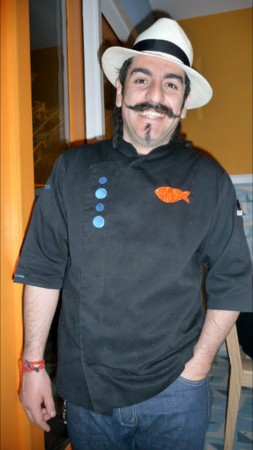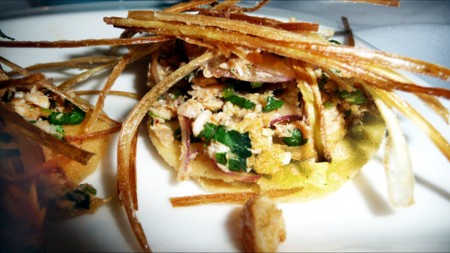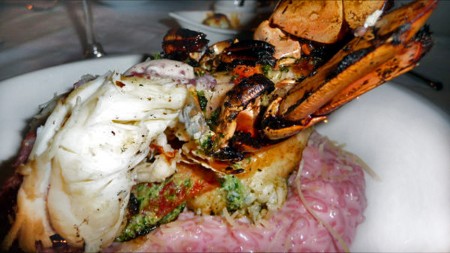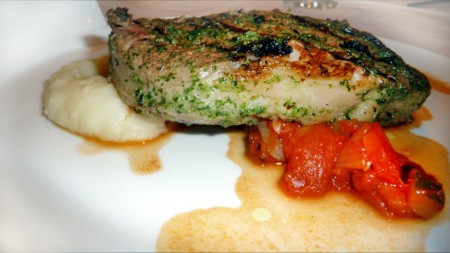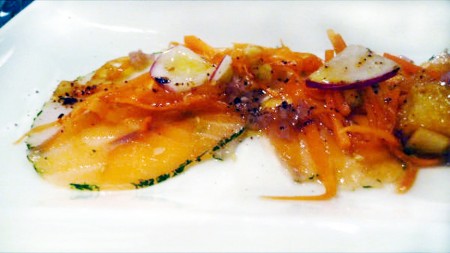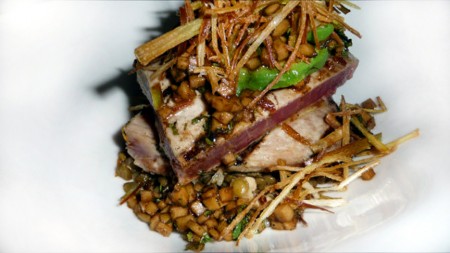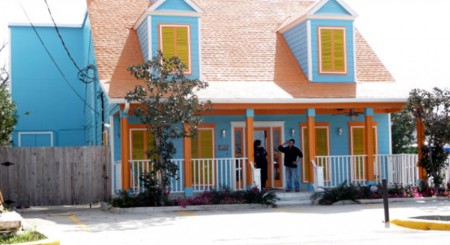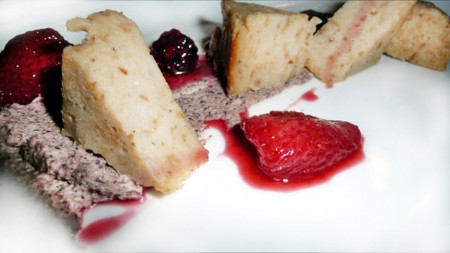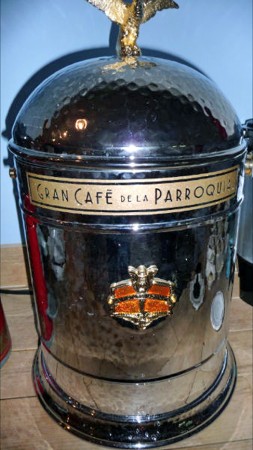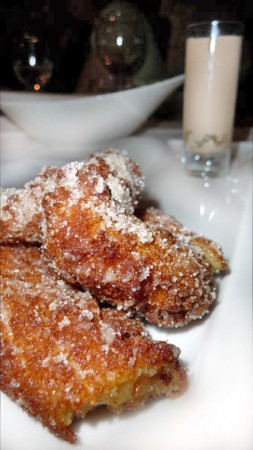La Fisheria – Seafood Mexican Cocina
Houston, Texas
Driving down Inker Street, the place that once housed a Vietnamese restaurant in the up-and-coming and semi-trendy Houston section of The Heights is not easy to miss. The pastel makeover on the exterior of La Fisheria Seafood Mexican Cocina makes the restaurant look more Jamaican or Brazilian than the typical neighboring Spanish-style Mexican restaurants with fake (or real) terra cotta roofs; it is colorful, intriguing and fun. A sneak peek inside the restaurant a week before its grand opening revealed those same colors prevalent in the interior décor as well, with an enormous amount of attention paid to the details. It all starts at the front door, where a wooden fish with painted-on “Aquiles” serves as the handle to the main entrance to the restaurant. Those that follow Chef Aquiles Chavez throughout Latin America on his cooking show “El Toque de Aquiles” and travel show focusing on food, “Aquilisimo” (on the Utilisimo channel) will recognize his style and familiar handlebar mustache. Chavez and Enita Riveroll are co-owners of La Fisheria (the Spanglish mix of “La Pescaderia” and “The Fishery”) which is the name of the restaurant as well as the reality show that follows Chef Chavez and his crew as they burn their bridges and head north of the border to Houston, Texas (since that time Chef Chavez has plans to expand south to Tabasco and Playa del Carmen).
It has been well documented in blogs, articles and live interviews how Chavez went to work for a popular chain of restaurants in Mexico as a dishwasher at age 16 out of a desire to buy an electric guitar, further developing a passion for the culinary arts that had started at age 3 in his mother’s kitchen. He went on to study at the Colegio Superior de Gastronomia, graduating in 2000. During his tenure there, he was taught how to have a love and respect for the profession, and that being a chef is an attitude towards life. These life lessons are why he gives back to the Culinary School with demonstrations, lectures and seminars and why he adds a dash of himself into anything he does.
The song “Border Patrol” by Eek-A-Mouse pops into the mental iPod while grabbing the wooden fish by the head and pushing the door open and walking past colorful iron bar-framed Acapulco lounge chairs facing a fall of Heart Leaf plants potted in large, vertical PVC pipes attached to the wall. The restaurant’s interior is an updated version of Villa Villekula; it screams fun and makes one feel welcome, however, with every minute detail the eye catches there is an understanding that there is also a passionate seriousness in what is being done here. Chef Chavez has put his touch on everything from the décor to the dishes he creates. He continuously jabs an elbow into my ribs during our conversation when he wants to tell me his latest vision for the restaurant or next dish; intrigued, I ask him about el peje lagarto, known in these parts as the gar fish. This fish is seldom used for cooking in the United States; however these prehistoric relics and oft-called “living fossils” have been used in the Tabasco region before the serpent warrior (conquistadores) laid foot on the Western Hemisphere. He answers, “Of course I will have it on my menu!” with a subtlety that lets me know it’s time to move past the dish that has made him famous; while justifiably proud of his peje lagarto, he is always looking forward. On this visit, Chavez served the fish in escabache on mini-tostadas and topped it with crispy nopal strands accompanied by a small dish of recado negro (or chilmolan, an Asian sate-style oil chile paste used in the Yucatan Peninsula and made with a yellow xcatik pepper, which resembles the Anaheim chili, but is smaller and a lot spicier).
The fish croquettes are made with a salted and reconstituted cod (bacalao) with piquin pepper aioli. This is typical bar food in the Yucatan peninsula, in Spain and in many Caribbean countries, a perfect appetizer, especially when accompanied by habanero margaritas. The mussels in beet coulis are a clever twist on traditional mussels in white wine sauce, and are topped with fried nopales. The question is not, “Why beets?”, but “Why not?” since purple beets are in season. Chef Chavez uses only readily available seasonal produce and meats, or has them shipped extremely fresh from the regions where they are naturally found whenever possible.
A grilled octopus with potatoes confit in Mexican vanilla oil was served on a speckled enamelware plate made in Mexico (as is almost all of the flatware, utensils, furniture and decorations found inside the restaurant). This dish screams “Baja!” – although Greeks are known for their octopus dishes, I believe even Zeus would be envious of the tenderness and flavor of the octopus, with a slight sweet flavor and aroma from the vanilla, and starch from the potatoes; this dish is my hands-down favorite starter of the evening’s fare. Chef Chavez serves his tostada de pulpo enamorado on a square, cut-out sheet of natural brown paper just like a tostada de ceviche would be from a street cart in a Mexican seaside village. The variety in plating styles makes the meal more enjoyable, as conversations quickly grow from comments typically accompanied by giggles and smiles. The tostada was a bit of a surprise, since I’m not accustomed to seeing pulpo enamorado served in a salad-style manner that includes the use of mayonnaise and chile chipotle (although I have had a similar tostada made with squid in Tlaquepaque, Jalisco).
On my visit, the menu featured a salmon and whitefish tiradito topped with Ensalada Fresca de Escuela (a familiar Mexican salad made with shredded carrots and sliced radishes) but there was still more seafood yet to come – the server emerged from the kitchen with a blue, speckled enamelware coffee pot and a plate (not a cup) in hand, pouring out a creamy, fragrant and hot cauliflower and shrimp aguachile soup. Aguachile is usually made by quickly marinating raw butterflied shrimp in lime and spicy peppers, and then serving the resulting brew on a platter topped with sliced red onion and avocado, sliced cucumbers usually surrounding the outer rim of the platter. A great aguachile will be served immediately after being prepared so as not to let the lime fully cook the shrimp, allowing them to maintain a little crunch to the bite. That crunch would not be expected coming out of a hot soup, but there it was.
The first entrée of the night was the pescado guachinango (red snapper) prepared pibil-style with mashed sweet potatoes and xnipec – a completely Yucatecan-inspired dish. The preparation is similar to the familiar and flavorful cochinita pibil, which is usually slow oven-roasted pork wrapped in banana leaves (after an overnight soak in a marinade of naranja agria (sour orange), crushed annatto seed, and other spices (commonly known as achiote). Xnipec is a typical salsa from Yucatan using habaneros as its base; Chavez did not shy away from bringing the heat throughout the night, and fortunately the dish comes complemented with creamy, mashed sweet potatoes in case things get out of hand. This was followed by yellowfin tuna steaks, perfectly seared and stacked and then dressed with roasted lentils and a crispy nopal salad and a beet risotto with a grilled Baja lobster tail (brushed with a cilantro-olive oil marinade), which allowed the chef to let his rasta hair down gently without scaring off the patrons.
La Fisheria carries the most extensive list of Mexican wines in the U.S., with most of the thirty-two bottles on the list coming out of the ever-growing popular Valle de Guadalupe wine country and purveyed by Baja Wines. The wine list includes familiar varieties used in Baja wines like carignan, palomino and tempranillo from familiar wineries such Pijoan, Tres Valles, and La Trinidad. A bacinilla (chamber pot) is used to chill the wines, which ensures that the gags never stop and the giggles continue throughout dinner.
Chef Aquiles Chavez is continuously looking for inspiration, as are all true artists. A visit with Chef Javier Plascencia of Mision 19 inspired the sous-vide rib-eye steak, finished on the grill after a light chimichurri marinade rub and then served with mashed truffle potatoes and ratatouille. Lamb chops are basted with chilmol (a black spicy sauce similar to mole), grilled and served over a bed of mashed plantains and topped with fried slivers of nopales. Rounding out the meat options was the codorniz (Rock Cornish hen) relleno negro with wild rice; the dish is typical of the Yucatan peninsula, which is traditionally served using turkey in a chilmol or recado negro (a black mole sauce that uses the spicy xcatik pepper).
Lest we forget dessert, Chef Chavez prepared a capirotada (a dish popular in Mexico during Lent, more commonly known as bread pudding in the English-speaking world). La Fisheria’s capirotada was accompanied by a fresh berry compote and a creamy cacao Chantilly. Their churros are made with freshly-ground Mexican chocolate using a metate (a milling stone mortar traditionally made out of volcanic rock). This sugary dessert was served with a caballito, a long shot glass of xtabentun (a Yucatecan liqueur made with anise seed, fermented xtabentun flower, bee honey, and rum, or in this case mescal). As with any decent Mexican or Latin American dinner, the meal was followed with a pastel de tres leches finished with fresh red berries and a red berry sorbet.
Such a huge, fine meal must be completed with a cup of coffee or espresso from Gran Café de La Parroquia from the State of Veracruz. The staff was outfitted with clothing typical of Veracruz, dressed to a T with guayabera shirts and Panama hats (although some opted for Chuck Taylors to be comfortable and casual). I am known for stating that “Despues de un buen taco un verde buen tabaco”, so the night was capped with a cigar in anticipation of my return for their ceviche bar at lunch the next day.
Although the debut of the ceviche bar was pushed back two weeks, Chef Chavez was kind enough to prepare their ceviche blanco (made with red snapper, lime, salt, spices, cilantro, sliced red onion, avocado and red radishes); all the utensils, tostadas, crackers, salsas, and sauces necessary for a cevicheria are neatly packed in a beer bucket. Other ceviches planned for the menu include a spicy rojo ceviche and a verde ceviche made with raw tomatillos. While most of my culinary adventures include caldo de camaron Cantinero, I would have to wait to stumble out of bar on 6th Street in Tijuana over to a cart on the corner to quench that craving; here in Houston, there were no clam and shrimp-filled clamato con cervezas like those made famous at Pedrin’s back when Avenida Revolucion was still claimed by the neighbors up north. My taco de pescado fix in Ensenada would have to wait until my return in the Spring – or maybe I’ll have to return to The Heights on Inker Street in Houston to compare their takes to my favorites from Baja, Nayarit, Puerto Vallarta and Manzanillo.
Before leaving, I joined Chef Chavez on the patio in weather typical of Southern California and asked him, “Why Houston?” He immediately let me know that Villahermosa, Tabasco is an oil town just like Houston, and that many clients from the oil industry he had at his two restaurants in that city (Lo, and El Tovar) travel back and forth between both cities. The 18th Ward of Houston (known as The Woodlands) also has a good amount of Tabasqueño transplants (former natives of the State of Tabasco, Mexico) that have shown their support for Chavez and his edible inspirations. When I asked him if he would ever return to Mexico to start another restaurant, he simply pointed to the wall and explained that he’s cut off all alternate plans in order to succeed in Houston (since his success in Houston, he is now casting his eyes back south). “Hasta la proxima” I said; “Please pick up the framed picture of tuna fish Benito promised me next time you are in Ensenada and send it to me” he answered. I let him know that I will probably personally bring it, to which he exclaims, “ARRE!”, as his extended finger let me know that I am number one. It is a good feeling to know that a chef is comfortable enough to mess around and bid me farewell in this way.
While he never did get that electric guitar, he is ready to rock the palate of Houstonians, Tabasqueños, and all those that are not afraid to mix it up a little bit, relax, and have fun.
NOTE: This article and accompanying photos are contributed by Chuy Tovar – please show him some Trippy Love.
La Fisheria – Seafood Mexican Cocina
4705 Inker Street
Houston TX 77007
GPS Coordinates: 29°46’31.65″N 95°24’31.66″W

